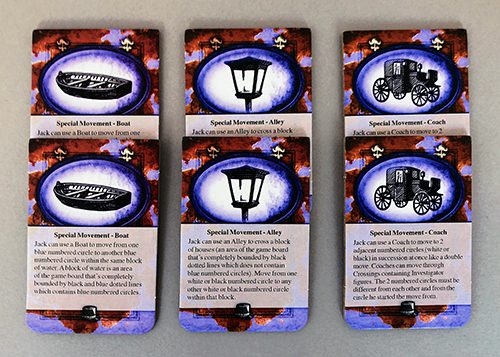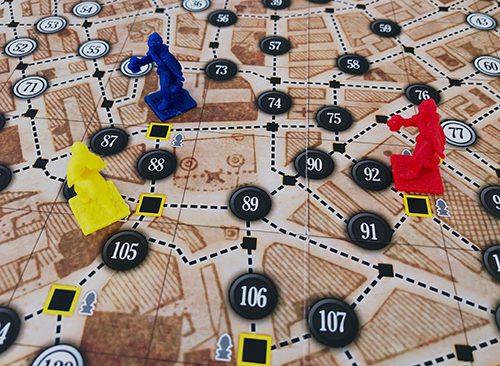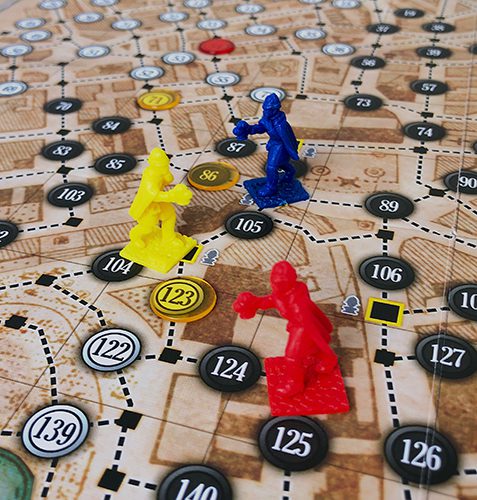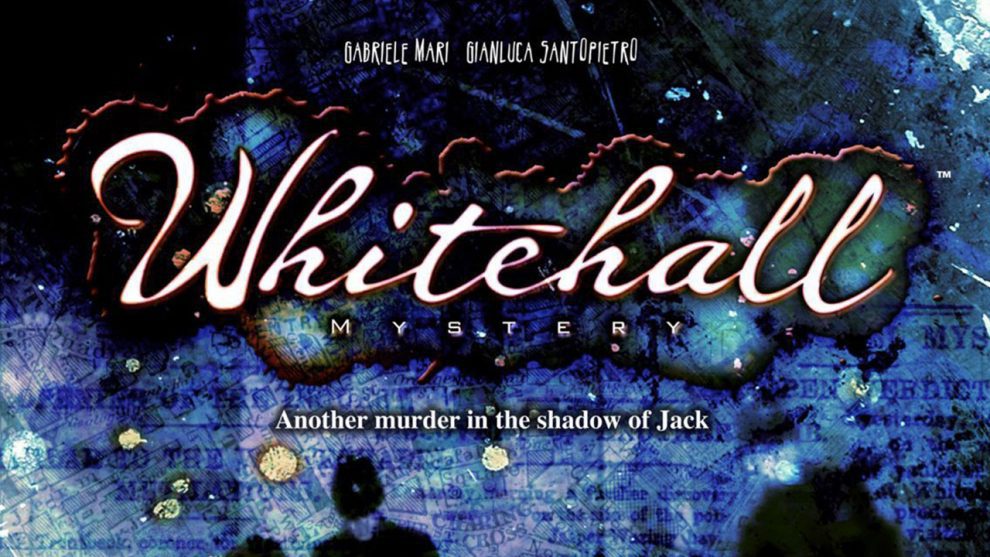Welcome to Whitehall
The year is 1888. The place: Whitehall, in the east end of London.
A killer is on the loose, leaving a trail of dead bodies behind him. He surfaces only to strike, then disappears back into the shadows. Investigators are on his trail, working through clues to capture the murderer before he can claim his fourth victim.
Whitehall Mystery is a one-versus-many game of hidden movements and social deduction. One player takes the role of Jack the Ripper, while up to three other players play as Investigators with London’s Metropolitan Police Service, working together to track Jack down.
Whether playing as Jack or as an Investigator, the game will carry you through up to four phases of a single, macabre night. If Jack is able to reach all four of his murder sites, he wins the game. If the Investigators capture or surround him, or if Jack fails to reach a victim in time, they win.
Setting up the Game
Whitehall Mystery is played on a square board that depicts a street map of the east end of London in 1888. Buildings and streets are illustrated in sepia tones, while The River Thames and St. John’s Park Lake are shown in muted blues, giving the board an old-world feel.

Throughout the board are dashed lines and circled numbers, indicating places where both Jack and the Investigators can travel on their journey across town. Black circles with white numbers divide the board into four quadrants. The four quadrants of the board, showing white circles with black numbers, indicate where Jack can and will strike unless stopped.
Dashed lines connect the numbered circles. These are the pathways Jack typically travels, down streets and across bridges. Along these dashed lines are black squares which are the spots the Investigators will stop to either search for clues at the numbered locations or attempt to capture the killer.
Players decide amongst themselves who will play Jack. (The rules recommend that the most experienced player take the role for the first game.) All other players take the role of the three policemen—regardless of the number of players, there will always be three policemen. If there are fewer than four players, each player is assigned one Investigator and any unassigned Investigators become shared amongst the investigating players.
Jack’s Killing Spree
The player acting as Jack is given a screen and a sheet of paper on which to write their moves. The screen keeps Jack’s notations a secret from the other players and, on the inside, provides a full representation of the game board. Jack can reference this map to determine his best path instead of looking at the board, where clever Investigators might follow his eye movements.

Jack examines the board and writes down four numbers, one from each of the four areas of the game board. These numbers (again, black numbers within a white circle) represent the places where Jack must reach to win the game.

Since Jack is moving amongst the shadows, he may only move from one circle to another directly connected circle once per turn.
Jack is also given three pairs of special movement tokens. One set allows Jack to take a Coach to move two spaces instead of one; another set allows Jack to slip through an Alley, that is, move from any space to another that surrounds the same dashed section of buildings; while the last set allows him to take a Boat across one section of enclosed water to another.

Jack also takes a small stack of transparent red plastic discs. These will be used to show where a body has been left.
After the Investigators place their characters on the board, Jack chooses which of the four spots he has written down will be the location of his first victim of the night. Jack then secretly writes down the number of the circle that marks his first move.
The Jack miniature is then placed at the bottom of the board on the space labeled 1 and a red disc is placed over the numbered space where the first body is found.
Investigators at the Ready
Players trying to capture Jack take one of the three Investigator miniatures and choose one of the five black starting squares to place their characters.

Players are given a stack of transparent yellow discs to mark the locations of correct guesses for Jack’s location. As well, if players decide to use them, each Investigator is given their own player token with a one-time special ability to be used during the game.
Playing the Game
The game is divided into as many as three rounds, with each round beginning with Jack placing a red disk over the number where his latest victim is discovered. Jack then moves from numbered circle to numbered circle on his way to his next chosen spot on the board.
Once Jack has placed his first red disc and marked his first move on his player sheet, the Investigators can discuss amongst themselves where they should move. The location of Jack’s first victim is clearly marked and with a limited number of connected spaces, Investigators can quickly work out the likely places where Jack might be.
Due to the Investigators’ starting positions, Jack will start several moves away from where they are. Investigators may only move from black square to black square, passing through the spaces where Jack may reside. However, in order to catch up, Investigators may move up to two black squares at a time—twice the speed Jack can move.
Once an Investigator has moved, they may either search for clues or make an arrest. To search for clues, an Investigator states they are searching for clues on any of the circled numbers directly connected to the black square they are standing on. (Think of them holding up a lantern along a dark street. Their line-of-sight only extends so far in the London fog.) Investigators must ask about each connecting numbered location one at a time.
If Jack was ever on the named location during that round, the Investigator places a yellow disc over that location and the search for clues ends for that Investigator’s turn.

Should an Investigator choose to execute an arrest, they must do so instead of searching for clues. The Investigator gets one chance to arrest per turn. If Jack is on that location, they win. If not, the Investigator’s turn is over and they are not able to search for additional clues until their next turn.
Jack is a crafty criminal: if an Investigator states they are searching for clues on a location where Jack currently is, Jack simply places a yellow disc over the numbered circle. Since the Investigator did not make an arrest, Jack may slip back into the shadows again.
In each round, Jack only has 15 turns to get from one chosen victim point to the next. When the Investigators are closing in, Jack will likely find himself in need of moving more quickly. Should he choose to use an Alley, Coach, or Boat movement cards, that special action will cost him two movement actions to use. (This is the only instance where Jack can move twice in a single turn.) The card is then placed at the bottom of the board, indicating it has been used.
Final Thoughts
If the game Scotland Yard is Whitehall Mystery’s grandfather, Letters from Whitechapel is its next of kin. In Letters from Whitechapel, Jack attempts to move from his hideout in London, to a chosen location, and then back to his hideout five times without being caught by the Investigators. The same designers decided to make a shorter, more compact version in Whitehall Mystery. (Where Letters from Whitechapel can take two hours to play, Whitehall Mystery comes in at under an hour.)
Along with condensing the game, a decision was made to change some of the artwork. While the maps remain largely the same in the two games, the cover image for Letters from Whitechapel and Jack’s screen make heavy use of dark reds. This makes for more gruesome imagery and might make the game less appropriate for both the squeamish amongst us and children. Whitehall Mystery trades the reds for dark blues, invoking dusk and darkness. The murders are represented only by translucent red disks, keeping allusions to the crimes to a minimum. All of this makes Whitehall Mystery more approachable to a wider audience, including families.
Whitehall Mystery is really two very different games. In one game, you’re one of the Investigators working together with your fellow officers trying to work out where Jack is and how to capture him. In the other game, you’re Jack, playing alone, trying to get to your next destination without being caught.
Playing as the Investigators is a collaborative effort, with each player offering their thoughts and suspicions before deciding where to move their pieces to search for clues. Working as a team, the responsibility is shared with ideas and strategies openly discussed. As Jack, you have a set list of destinations you must reach in front of you, and the slow task of moving from one circle to the other. You’re alone with your secrets, while the Investigators have both speed and the number of players on their side.
I’ve played many times as Jack and as an Investigator and find I enjoy each role equally, despite just how very different the two are. It’s just as much fun to be Jack and try to outwit all of your opponents as it is to join forces with teammates to figure out where your opponent is and capture him before he claims his fourth victim.
The most surprising thing to me about Whitehall Mystery is the very real sense of pressure I’ve experienced when playing as Jack, and I’m not alone in this feeling either. It’s very uncommon to find that kind of stress in a board game, but the designers of Whitehall Mystery have done a great job of creating an exciting, accessible game that mixes tension and fun. It’s telling that each time I’ve taught the game to a new group, each group has wanted to play it again right away, with people volunteering to play Jack.
Whitehall Mystery is a fun, accessible game that not only offers two very different gaming experiences, but is also guaranteed to generate spirited discussions both during and after the game.












Add Comment